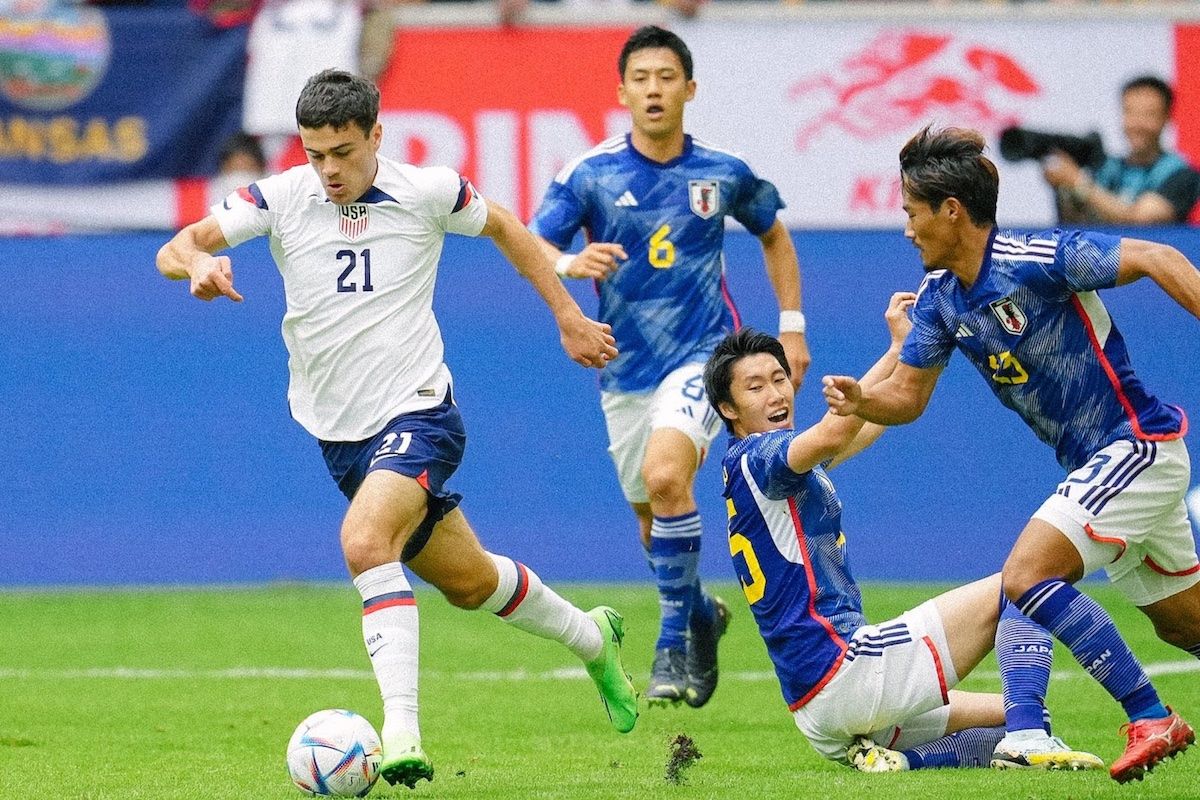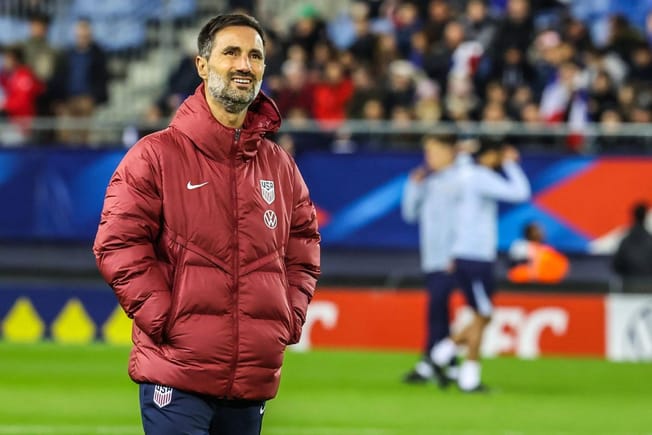Quick Hits
- Gregg Berhalter’s U.S. men’s national team took just four shots against Japan in their 2-0 loss on Friday
- With only 90 minutes of soccer left before the World Cup, the United States must improve on the ball if they want to truly threaten in November
“We want to use the ball to disorganize the opponent and create goal-scoring opportunities.”
That’s how Gregg Berhalter described his tactical philosophy back in 2019, just weeks into his new job as the manager of the U.S. men’s national team.
Now, the USMNT’s tactical approach has changed since their first game under Berhalter. They’ve become a more aggressive, pressing team. They’ve varied their attacking approach, too. But like we saw in the United States’ 2-0 loss to Japan, there still are games when the U.S. need to break down an organized defensive structure.
And in one of their final games before the World Cup, they couldn’t do it.
Berhalter’s team took just four shots against their very aggressive and well organized opponents. Japan forced the U.S. to play through them and create chances and, after 90 minutes, the USMNT largely failed at both of those things.
— Paul Carr (@PaulCarr) September 23, 2022
Being a polished, aesthetic offensive team isn’t a necessary component to winning soccer games. You can compete at, and even win, the World Cup without dominating possession and playing out of the back. But it’s difficult to be a truly dangerous team if you can’t leverage the ball and whatever space the opposition is giving you into attacking chances. In a matchup with one of the very best teams they’ve played in the last four years, the U.S. struggled to create chances on Friday.
So, what went wrong for the United States against Japan? And how can they set things right with just 90 minutes of soccer left between them and the World Cup? Let’s talk about that.
U.S. STRUGGLED IN BUILDUP
Much of the United States’ game against Japan was defined by one battle: their buildup vs. Japan’s press. Playing out of Berhalter’s preferred 4-3-3 shape, the U.S. tried to build through Japan’s pressure, but they had very little success.
According to Opta, the U.S. had 20 “high turnovers” (turnovers deep in their own half, which are high up the field for their opponents) against Japan. From those high turnovers, the U.S. allowed six shots and one goal. In all 14 of their World Cup qualifying games, they allowed seven shots and no goals. That absurd increase stemmed from Japan’s decision to press higher up the field in ways that most of the USMNT’s Concacaf opponents avoid. But it also stemmed from some individual and team-wide errors.
The #USMNT conceded seven shots and no goals from high turnovers in 14 qualifying matches. Today in 90 minutes against Japan: pic.twitter.com/RVoQNfVz6c
— Opta Analyst US (@OptaAnalystUS) September 23, 2022
Aaron Long struggled with his distribution and had a tone-setting unforced turnover less than 60 seconds into the game. Weston McKennie did… whatever this is in the 24th minute, which created the runway for Japan to break forward for their first goal. Those unforced errors from Long, McKennie, and a host of others killed any brief positive periods that the United States had on Friday.
Sloppy touches weren’t the only thing killing the U.S. on Friday, though. Poor spacing also hurt the USMNT’s ability to play through Japan’s 4-4-2 and exploit the space behind their backline.
Take this sequence in the 13th minute as an example. As Walker Zimmerman looks for a passing option in buildup, Luca de la Torre moves wide to provide width as Sergiño Dest pushes up the right wing. But there’s a problem. De la Torre doesn’t actually move wide enough to get open or to create a passing lane for Zimmerman to find Brenden Aaronson in the right halfspace.
Instead, he clogs up the midfield and doesn’t take Takefusa Kubo out of the play, which lets Kubo intercept Zimmerman’s pass and launch a quick attack for Japan. Two seconds later, Matt Turner is forced into a big save.
Walker Zimmerman is going to get toasted for this turnover, which is fair.
— Joseph Lowery (@joeclowery) September 23, 2022
But man, Luca de la Torre *has to* be wider here. He doesn't give Zimmerman a real option out wide. Instead, he makes makes it easy for Kubo to step in, intercept, and break forward. https://t.co/mMztRFblD7
With poor spacing, unforced errors, and some overly methodical play, it’s no wonder the United States struggled to generate shots against Japan.
SOME SIMPLE SOLUTIONS
The good news for the U.S. is that a lot of their attacking issues on Friday are fixable.
Tweaking some of the positioning in possession can be solved with a short film session. And maybe Berhalter used halftime against Japan for that very thing. The U.S. looked more comfortable in the second half, partially because Japan dropped their line of confrontation and partially because they were more precise with their movement off the ball.
The USMNT still created almost nothing in the second half after switching to a 3-2-5 in possession, but they had more functional attacking moves. They also arrived in the final third more frequently and cut down on the turnovers. Speaking of turnovers, we should expect the USMNT to cut down on their sloppy passes and poor touches.
If that turnover-filled first half wasn’t an anomaly, the United States will be in serious trouble at the World Cup.
TIME TO GO DIRECT?
There’s one other thing we have to discuss here when it comes to the USMNT’s attacking issues. It’s this: many of the U.S.’s outfield players on Friday against Japan aren’t very good at using the ball to create chances.
Think about Turner, Long, Zimmerman, Tyler Adams, McKennie, and Aaronson. Are those players comfortable on the ball under pressure? Are they exceptional ball progressers? Or great chance creators? No, not really. Those players will have the occasional good moment in tight spaces. They had a few of those moments even in a messy game on Friday. But they’re not, primarily, players you want building from the back under disciplined pressure.
And yet, Berhalter had the U.S. build attack after attack with passing that started in the back and attempted to bypass Japan’s press. At this point, we know how that story ended.
So what’s one final solution here for Berhalter and the USMNT? Play more direct passes.
“Verticality” was a major buzzword for the United States throughout World Cup qualifying in 2021 and in the beginning of 2022. The U.S. had a few great moves back in June that used vertical runs to exploit the space behind their opponents’ defenses. Remember that ridiculous first touch and assist from Christian Pulisic against Morocco over the summer? That came from a run out of midfield and into space.
Zimmerman ➡️ Pulisic ➡️ Aaronson
— Wagr (@withwagr) June 2, 2022
USMNT defeats Morocco 3-0 👏⚽️pic.twitter.com/f2NcLhnAD1
The United States had almost no line-breaking runs against Japan.
Josh Sargent occasionally ran behind the backline in the second half, but the USMNT needed more. Even teams that prioritize short passing in possession still use direct passes as a way to punish defenses for stepping too high up the field. With a starting lineup mostly composed of players who thrive in quick, long passing schemes and second-ball scraps, the United States made life more difficult for themselves by relying so heavily on buildup play and short passing.
To be totally clear, the players that Berhalter used against Japan had enough quality to play through their opponents and create chances. Like I said up above, the USMNT’s turnovers and spacing problems are fixable and there’s plenty of blame to go around for the 16 U.S. players who stepped on the field in Dusseldorf and failed to execute. They were sloppy and, at times, lacked positional awareness.
But Berhalter could have avoided some of those issues altogether by instructing his players to find more direct passes.
The U.S. have done it before (think back to all of their games against Mexico over the last two years) and they had a chance to do it again on Friday. Instead, they chose to lean in the opposite direction, away from that vertical game and even away from a balanced attack. Given that they have some technically limited players in key positions, the United States can’t afford to forsake that balance.
Time is extremely limited, so finding some sort of attacking balance in what little of it remains before must-win games in November is essential for the USMNT.







Comments